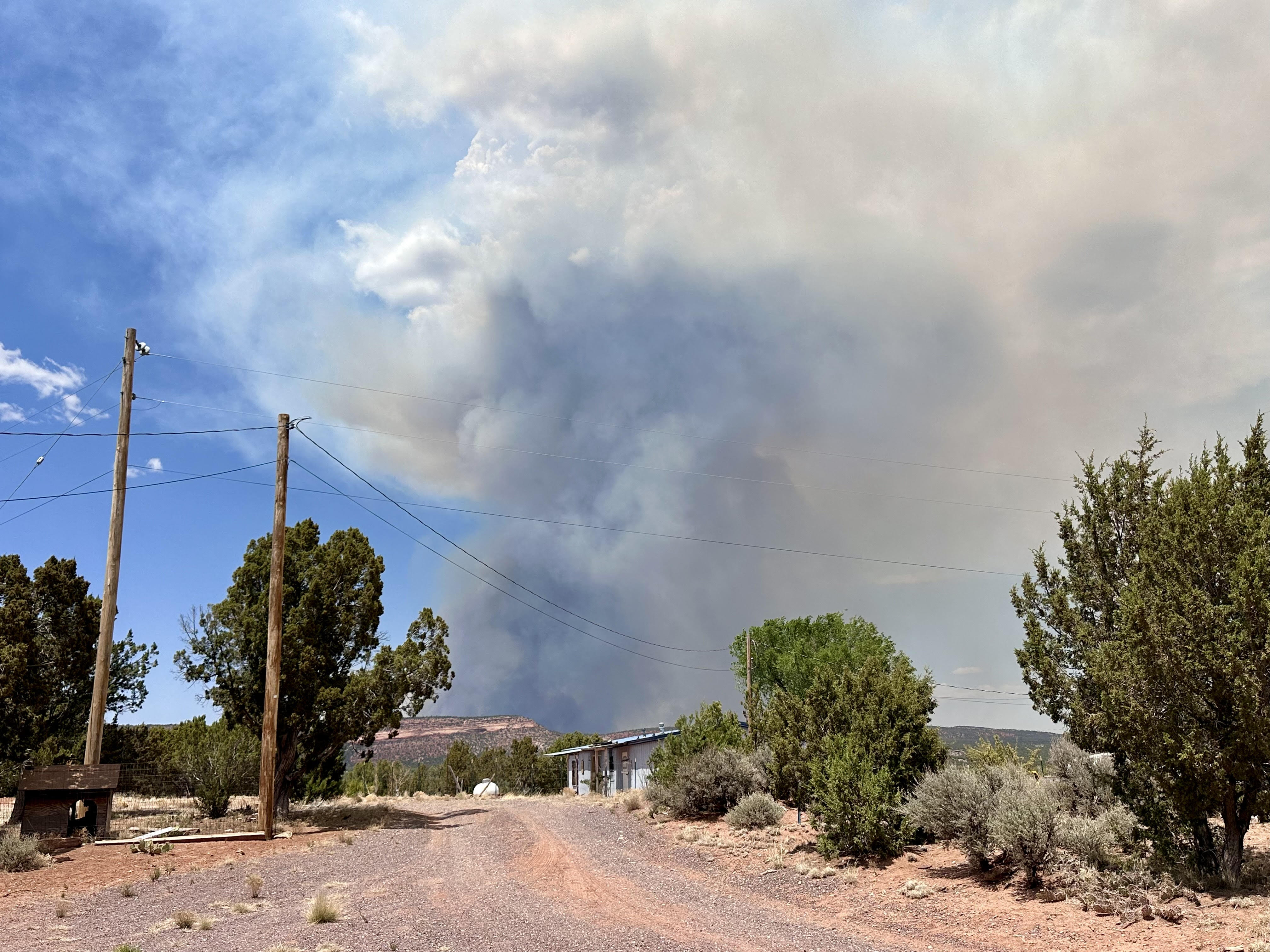
- Details
- By Holly James
FORT DEFIANCE, Ariz. — What is now called the Oak Ridge Fire, currently at 0% containment, has burned over 10,624 acres as of this morning located just a few miles near the heart of the Navajo Nation’s capital over the last four days since the onset of the fire on June 28.
Roughly 55 firefighters were the initial team to respond.
Navajo Nation Fire Rescue were first to arrive, with BIA Wildland Fire Navajo Region arriving roughly 15 minutes after. Navajo Pine Volunteer Fire Department arrived 2-3 hours after, and Ganado Fire Department arrived later that evening from the onset of the fire.
The 55 held the line battling the flames for a continuous 48 hours until other resources from surrounding areas, states and agencies could provide relief and demobilize the initial team to allow for rest and recovery for the 55.
BIA Wildland Fire Management held a town hall on Monday evening for the Navajo Nation communities at the Window Rock Veterans' Memorial Field House to provide details on the fire, resources available, and instructions on the Ready, Set, Go evacuation concept in preparation to possibly evacuate, and expectations of fire behavior that continues to impact and displace residents and livestock in St. Michaels, Hunters Point, and Oak Springs.
During Monday’s town hall officials reported that 6,546 acres had burned from the start of the fire, however at the time of the report, they faced a looming threat of the onset of high winds in the late afternoon and throughout the evening increasing the difficulty in suppressing the blaze resulting in an additional 3000 additional acres Monday night.
BIA reported this morning a total of 508 Firefighters from various tribes, states, and federal resources are active on site including Navajo Hot Shots and the Geronimo Hotshots representing the San Carlos Apache Tribe. Additional resources from various entities are expected to arrive daily.
Over 100 families have evacuated, no injuries have been reported, a few chose to have stay in the area, and over 350 people have been evacuated to the local shelter at the Bee Hółdzil Fighting Scouts Events Center. Livestock are also being evacuated to the Dean C. Jackson arena at the fairgrounds where the animals will be provided care, food and treated for any injuries by the Navajo Nation Agricultural Department.
The public is to be aware that that no official monetary platform to donate has not been authorized or established.
Navajo Nation Police Lt. Tyler Lynch is serving as Incident Commander of the Oak Ridge Fire Incident Command Post. Lynch spoke at the town hall providing public resources to stay informed.
https://nativenewsonline.net/currents/navajo-nation-communities-briefed-as-oak-ridge-fire-remains-at-zero-containment-2#sigProIdc14dffdd2a
Lynch also explained the “Ready, Set, Go” preparation protocols stressing the community members to be proactive verses reactive if notified to evacuate.
The Navajo Nation lacks a protocol and official emergency broadcast system within its vast 27,000 square miles. When these types of emergencies arise, there are no broadcasts issued within the local television station, radio, or text to alert the masses of an emergency. The main source of communication that has been relied on is social media. This poses a grave concern for residents living both living rural and urban areas with no access to basic necessities as electric, WiFi, telephone.
Navajo Nation Speaker Crystalyne Curley and delegates from the impacted areas quickly formed at their local chapters to establish direct efforts, and boots on the ground going door by door alerting their community members of the severity of the fire.
At an incident command briefing, Speaker Curley expressed dire concern at the lack of action and uniform information specifically to the communities of her Nation. Speaker Curley and delegates from the impacted areas led the effort to issue radio public service announcements in English and Navajo detailing the emergency, where to go for information, shelter for themselves, livestock. The Office of the Speaker has also been diligent with press releases and being a liaison within the tribal government,
BIA Wildland Fire Navajo Region continues to provide daily updates throughout the day at the various command sites on theNavajo Nation to first responders and Navajo government officials. BIA is also providing public updates on their social media Facebook page.
Stay tuned for a series of information as this fluid situation continues to develop.
Resources below:
BIA Facebook: https://www.facebook.com/BIANavajoRegion
“Ready, Set, Go” evacuation system, refer to https://ein.az.gov/ready-set-go.
Interactive evacuation map can be found at https://tinyurl.com/4b7uaapn
A 24/7 fire information call center is available at (505) 422-7382.
Watch Duty: https://app.watchduty.org/i/52994
Photographs by Holly James for Native News Online.
Help us defend tribal sovereignty.
At Native News Online, our mission is rooted in telling the stories that strengthen sovereignty and uplift Indigenous voices — not just at year’s end, but every single day.
Because of your generosity last year, we were able to keep our reporters on the ground in tribal communities, at national gatherings and in the halls of Congress — covering the issues that matter most to Indian Country: sovereignty, culture, education, health and economic opportunity.
That support sustained us through a tough year in 2025. Now, as we look to the year ahead, we need your help right now to ensure warrior journalism remains strong — reporting that defends tribal sovereignty, amplifies Native truth, and holds power accountable.
 The stakes couldn't be higher. Your support keeps Native voices heard, Native stories told and Native sovereignty defended.
The stakes couldn't be higher. Your support keeps Native voices heard, Native stories told and Native sovereignty defended.
Stand with Warrior Journalism today.
Levi Rickert (Potawatomi), Editor & Publisher


